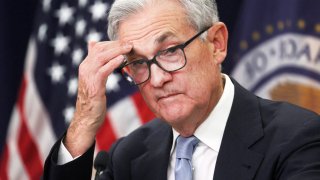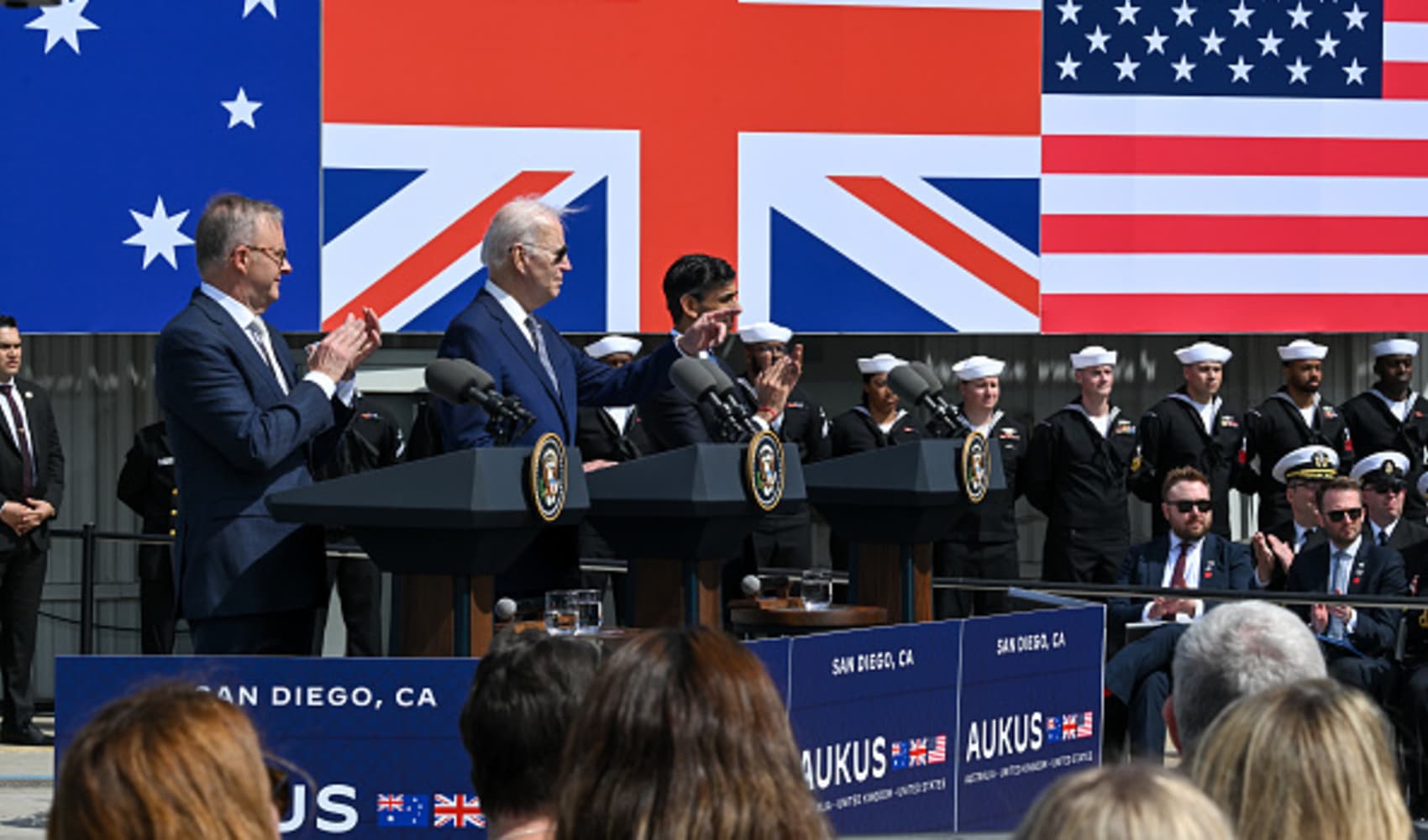
- The new CNBC Fed Survey finds 72% of economists and fund managers saying the Fed will hike rates this week at its FOMC meeting.
- But only about half of those surveyed (52%) think a 25-basis point increase is the correct monetary policy move.
- About half of respondents say systemic risks in the banking system should take precedence over inflation.
Bets on the Federal Reserve's next move have been all over the place over the past month, from increased expectations of a 50-basis point hike, to no hike at all, and now back to a majority view that the Fed increases benchmark interest rates by 25 basis points when its Federal Open Market Committee (FOMC) meets this week. But if the latest majority view turns out to have twisted and turned its way to being correct, it's not because the market is convinced a hike is the right move for the Fed, according to a new CNBC Fed Survey.
Almost three-quarters of respondents (72%) expect the Fed to hike by one-quarter of a percentage point, according to the CNBC survey, but only 52% say the Fed should hike. On Tuesday morning, the CME FedWatch finds the market pushing up bets on a 25 basis point hike to over 81% (it had been 74% on Monday).
Get Tri-state area news and weather forecasts to your inbox. Sign up for NBC New York newsletters.
With the central bank now facing the risk of financial contagion after the failures of Silicon Valley Bank and Signature Bank, and concerns about the potential for a regional banking crisis, many on Wall Street think it would be better for the Fed to hold some dry powder in reserve. Just over half (52%) of economists and money managers polled by CNBC think financial stability is a bigger issue for the Fed now than inflation, and almost three-quarters (72%) rate the level of systemic risk as being high.
The Fed's dilemma: whether it can instill confidence in the market and prevent the economy from a hard landing while keeping its financial stability tools — including buying bonds at par from banks and the discount window — separate from its inflation-fighting monetary policy tools, the higher rates and balance sheet reduction.
The risk: these forces overlap, with the banking crisis leading to tightened credit at banks and creating enough disinflation to slow the economy.
Money Report
The problem for Fed Chair Jerome Powell and the FOMC: there hasn't been enough evidence in the data to suggest the fight against inflation has progressed to the point where it should have confidence that credit tightening can do the disinflation job without another rate hike.
Wage growth has cooled, but remains strong, job growth is still running at a hotter pace than expected, and even as CPI has come down, recent revisions show that the progress made in bringing prices down hasn't been quite as good as the initial data suggested.
Mohamed El-Erian, chief economic advisor at Allianz, recently told CNBC that if the Fed decides to pause he fears the result will be stagflation. Any move by the Fed to back away from the inflation fight, "is not good for the long-term," he said on CNBC's "Squawk Box."
"The longer we allow the inflation problem to get embedded in the system, the greater the cost to society, and it's miserable for Americans and the markets," he said.
The Fed's message now, according to El-Erian, should be two-fold. First, it has two sets of tools to deal with inflation and financial stability, and it can't confuse those two. "The lesson of the last few years is every time we do so, we fall into a muddled middle and end up worse off," he said. "Hike by 25 basis points, and explain these other tools which are really powerful for financial stability."
Three participants in the CNBC Fed Survey break down for us what the Fed is likely weighing and thinking as its two-day FOMC meeting begins.
The Fed's decision tree of three
Kathy Bostjancic, Nationwide chief economist, sees the Fed's dilemma in a decision tree of three options.
If the market is correct about the 25 basis point hike, then the question becomes what type of messaging and guidance the Fed offers.
"Is it a hawkish 25 bps rate hike, meaning the Fed sees ongoing rate hikes as likely, or a dovish 25 bps rate hike where it declines to give forward guidance similar to the European Central Bank's 50 bps rate hike last week?"
The third option: Fed officials could indicate that they need time to assess how much tighter bank lending and credit conditions overall have become, she says, knowing that small and medium-sized banks provide about 68% of all lending to small businesses and this will lead to slower economic activity.
Bostjancic also notes that prior to the recent banking stresses, bank lending standards as reported by the Fed's Senior Loan Office Opinion Survey were already markedly tightening, with over 40% of banks reporting tightening standards, which in the past was at a level consistent with recessionary conditions.
The bond market is now pricing in the possibility of a rate cut starting in June, with about 60 basis points of rate cuts priced in by year-end. She thinks that is premature, outside of some greater financial crisis, but conditions are deteriorating. Inflation will likely slow more quickly than we previously anticipated, but it remains very elevated, and her outlook is an economy headed for a moderate recession starting in the second half of 2023, "with risks of a harder landing rising."
The CNBC Fed Survey pegs the start of a recession in September.
The case for the 'pregnant pause'
The Fed choosing to keep some of its hawkishness in reserve is the idea that Diane Swonk, chief economist at KPMG, sees as likely at the FOMC meeting. "I am looking for the Fed to do a pregnant pause - deliver later if necessary," she said. "Given the credit tightening we have in the pipeline; it could do the heavy lifting for the Fed."
A pause and the threat of a subsequent hike leaves all the options open to be ready to combat more persistent inflation, Swonk added.
The European Central Bank's decision last week to raise by 50 basis points has been cited as an indicator of where central banks are in the fight against inflation, but Swonk noted that the Fed is further along in rates hikes than the ECB. She does think the Fed will make one move similar to the ECB: hold off on releasing its forecasts on the economy and the trajectory for rate hikes. "That would add confusion rather than clarity given what is still unknown in the pipeline," she said.
Hike without hesitation
"Plow ahead with 25 basis points," is how John Ryding, chief economic advisor at Brean Capital, put it.
Despite what this past few weekends may have triggered for those who lived through the 2008 Bear Stearns situation – the beginning rather than the end of worse to come for the markets – the underlying inflation fundamentals must remain at the forefront, he says. It wasn't even two weeks ago that Powell signaled the inflation fight was not going as well as the Fed hoped and it might have to do a 50-basis point hike.
"That was a big mistake," he said. But unlike in 2008, the Fed has tools to fight bank issues that are distinct from rate hikes, and banks overall remain well capitalized while the inflation fight isn't proceeding as well as the Fed hoped.
The risk of repurposing monetary policy to focus on financial sector stability is too big. "The reaction would be, 'what do they know that we don't know," Ryding said. That undermines the confidence-building efforts the Fed, Treasury and FDIC have taken to date. "It's not easy to put out these crises of confidence," he added.
Long-term inflation expectations have remains anchored, with inflation break evens now signaling "low 2%s" over the next 5 to 10 years, and that is one favorable inflation reading for the Fed, he said, but added, "there is very weak criteria to say that inflation has peaked," especially for a Fed that two weeks ago thought it was appropriate to raise rates above 5.25%. "That would be a massive revision."
The end of this Fed monetary policy cycle is near
As the Fed weighs whether a pause is warranted, the Fed survey finds that whatever the FOMC does this week, the central bank is nearing the end of its interest rate hiking cycle.
The peak rate will still reach over 5% (5.2%, according to the survey), but 86% of respondents think the Fed will start cutting rates, or at least pause, by its July meeting. This expectation is a little more hawkish than the Fed futures market, which is pricing in a peak rate of 4.93%, and expects rates to begin a retreat in October and be down by almost 70 basis points by the end of the year.






